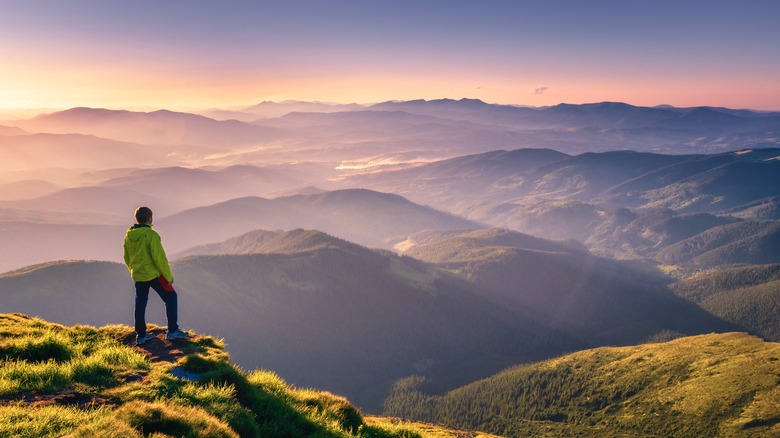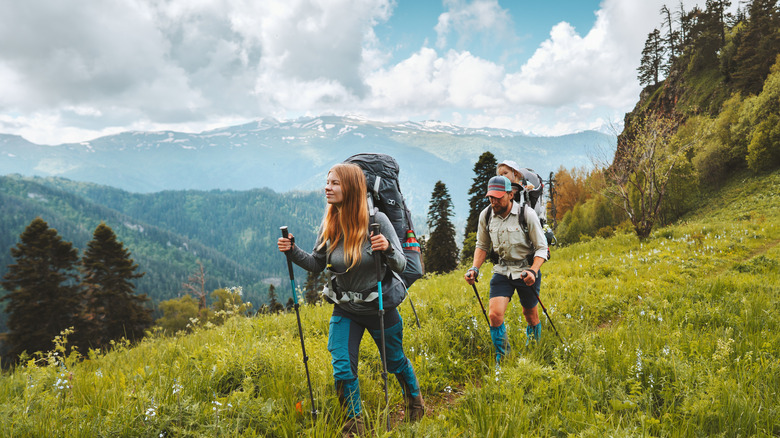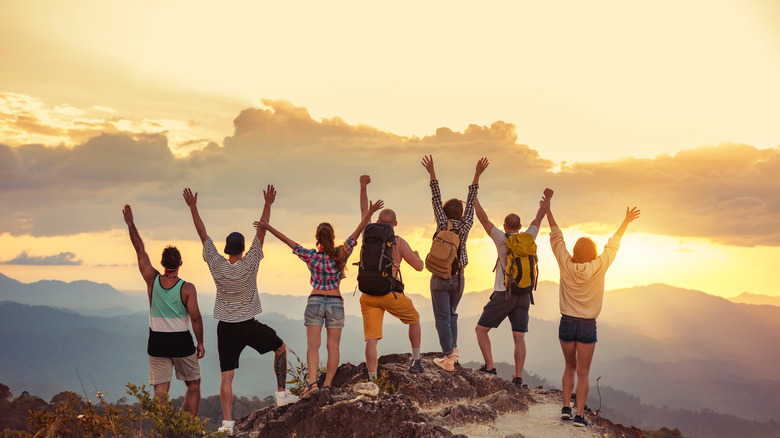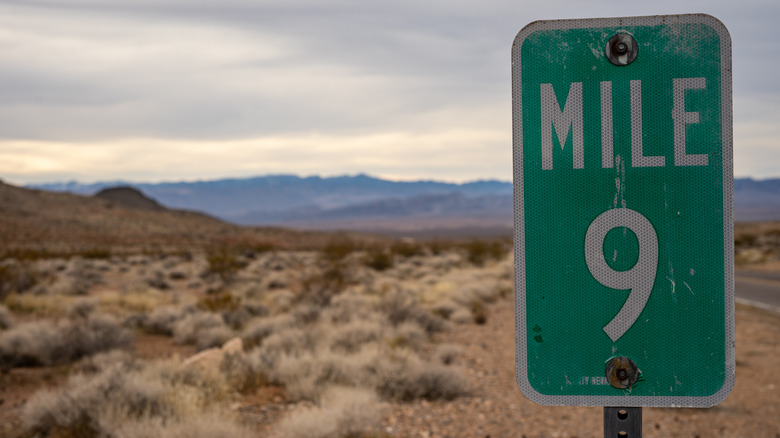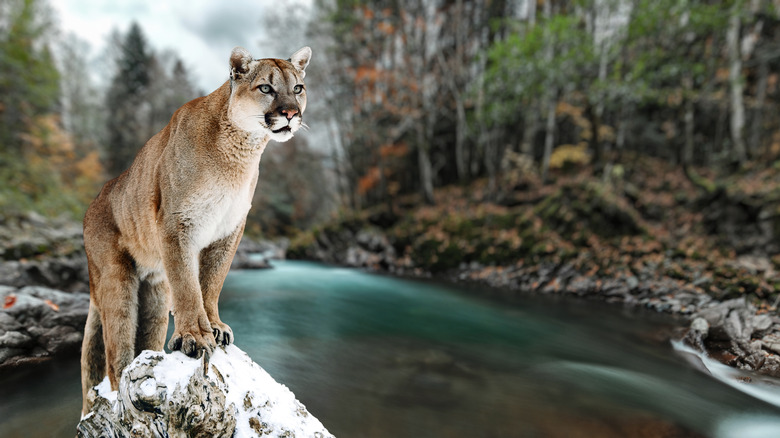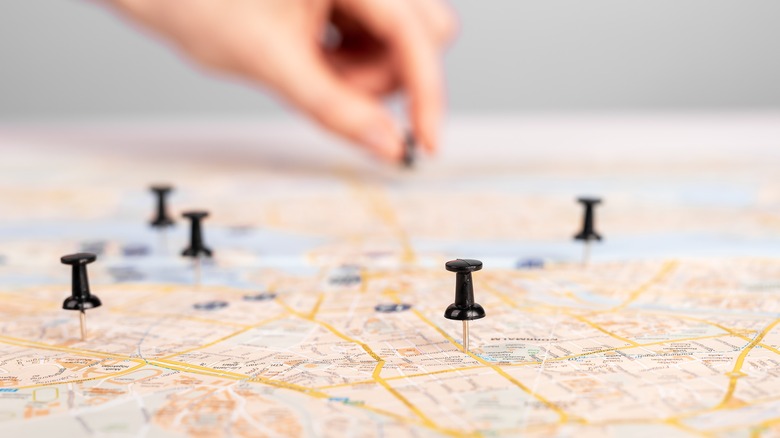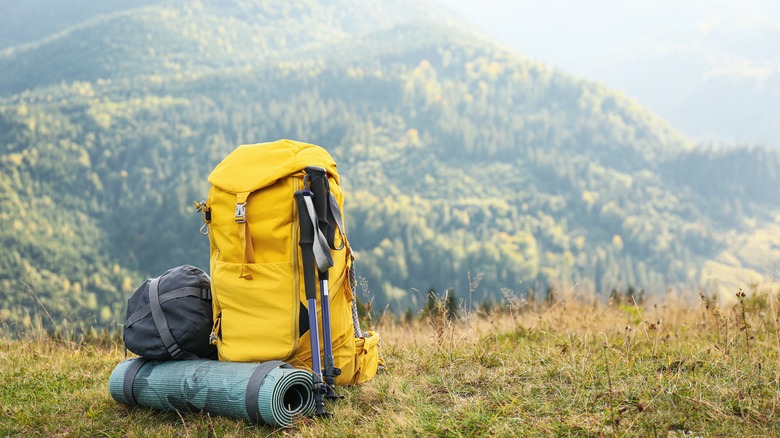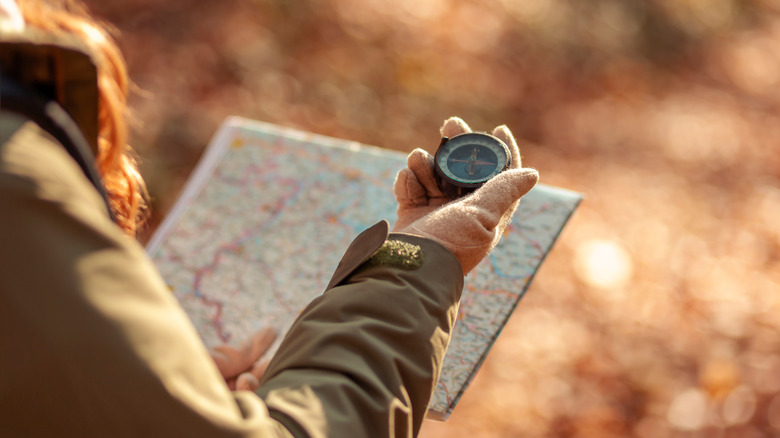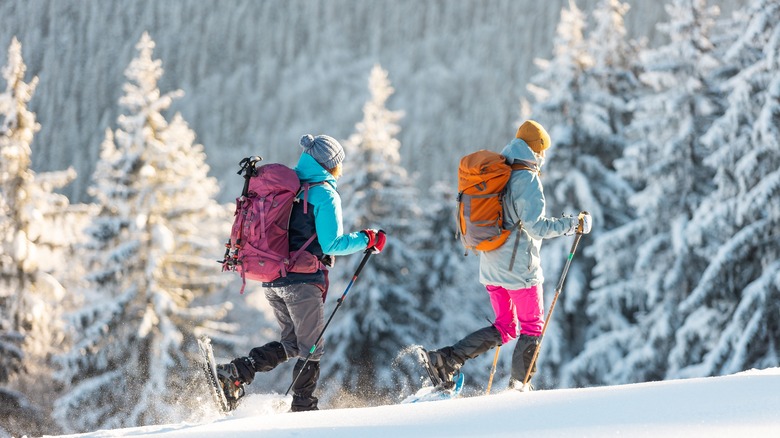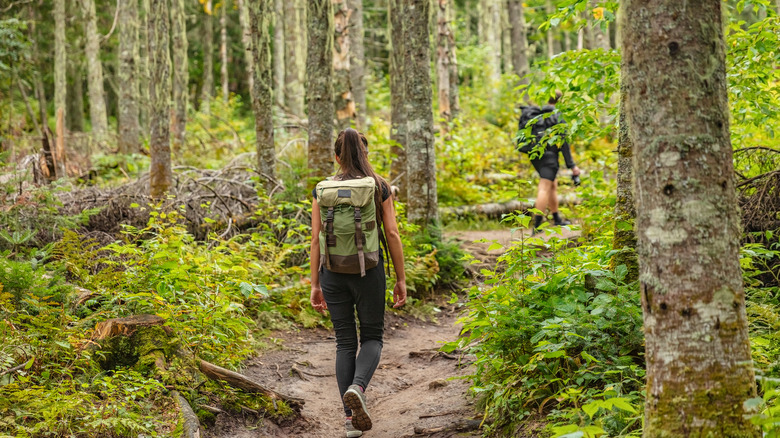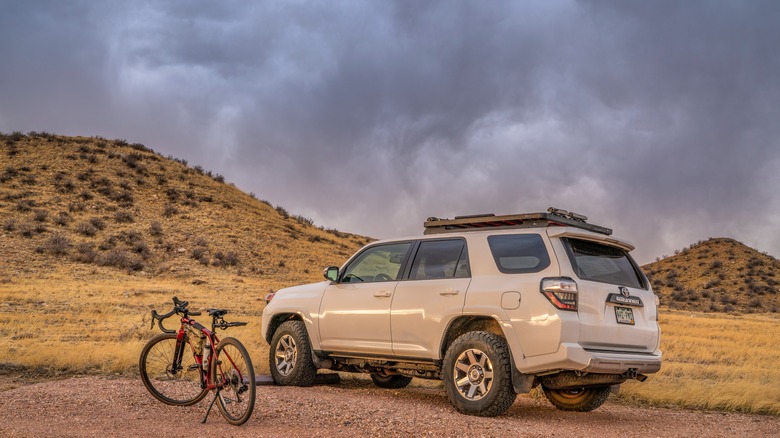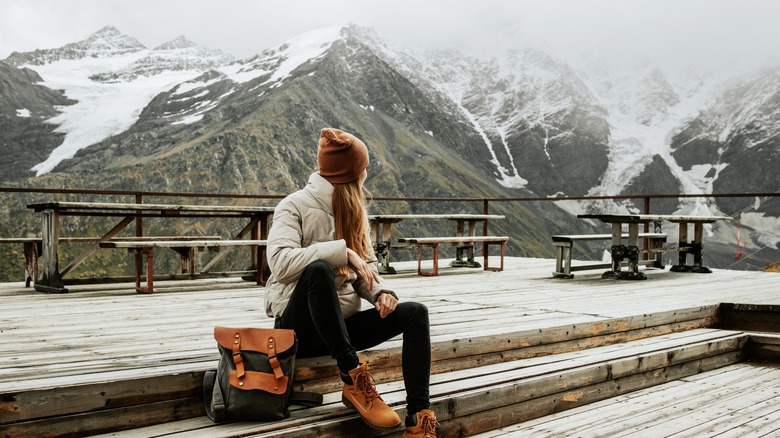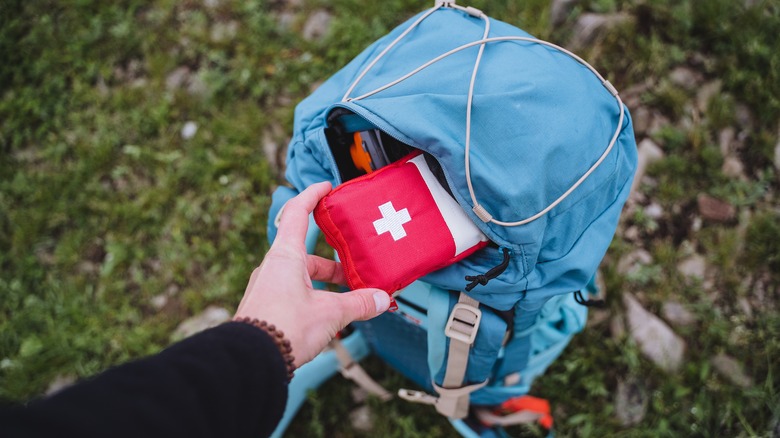12 Tips To Help You Feel Safer While Hiking Alone
Solo hiking is one of the best activities you can do on any trip. Even if you aren't the biggest outdoors enthusiast back home, everyone can benefit from some time on the trails while traveling. By hiking, you'll catch views you'd miss by sticking to the city or town center or by exploring by car or train. You might even end up discovering a true hidden gem or viewpoint you would have otherwise missed — even right in your own backyard. Not to mention, hiking is an easy way to stay fit while on the road or at home.
It's a great solo activity — as long as you're prepared! So whether you're taking a multi-week backpacking trip in the Alps, a road trip around national parks, or just looking to escape the urban jungle for a day hike, you'll need to plan and prepare to do so safely in order to have the most enjoyable experience. So, make sure to keep the following tips in mind, no matter your level of expertise (or lack thereof).
Evaluate your experience level and select a trail that matches
The very first thing you'll want to do, maybe even before you select a destination, is evaluate how experienced of a hiker you currently are. It's great to have aspirations to conquer Everest in Nepal or Mont Blanc in the French Alps, but if you've barely done more than a neighborhood walk, you'll need to recalibrate your expectations. If you are a novice hiker, it doesn't matter how much you want to summit the Matterhorn or Kilimanjaro, you need to start small.
If you use tools like All Trails or Modern Hiker to search and plan routes, you'll need an idea of your skill level to choose an appropriate hike, as these apps use a ranking system. The Simple Hiker recommends sticking to these suggestions if you're a newbie. Then, as you gain experience, you'll have a greater understanding of the distance, elevation gain, and terrain you can handle and prefer. If you frequently hike at home, you'll still need to pay close attention so you don't pick something too short or easy that will leave you disappointed. The U.S. Forest Service provides a handy rating system for trail difficulty that you can use to assess your level. Whatever you land on, please be honest with yourself, this is more than a matter of catching great views, it's a huge safety concern, especially when hiking alone.
Consider sticking to the most popular trails
No matter your experience level, if you're hitting the trails solo, it might be a good idea to stick to popular ones. That way, if you run into trouble, there's a higher chance you'll be discovered or encounter someone who can help a lost hiker. Also, if you're hiking in an area where wildlife is of potential concern, a more frequented path means more noise that will keep bears, cougars, and whatever else you might cross paths with away.
Beyond Wild Places suggests opting for an easier hike if you're on your own to avoid potential injury or obstacles that are more likely to occur on strenuous routes. Even if you're super experienced and hike all the time, it's a different game when hiking solo. You might embark on a less-traveled path only to become totally turned around or disoriented. You might not see anyone else on the path who can point you in the right direction. Or maybe you opt for a difficult scramble and turn an ankle and have to wait hours for help to find you. Of course, you're the best judge of what makes sense for yourself and you don't need to select hikes out of fear, but it's important to keep in mind. Remember, safety in numbers!
Note the numbers
When we say "note the numbers," we're not talking about the prices of permits or parking (although, those are also notable), but rather, the digits attached to your hike of choice. A lot of these numbers are going to be based on your hiking level and comfort, which is why it's important to establish that first and get a sense of what that means for difficulty ratings.
Distance is significant when selecting a hike. You don't want to set off on a 10-mile journey only to realize halfway through that you won't make it back before dark. However, the length is just one important piece of the safety puzzle. As pointed out by The Big Outside, elevation gain is equally, if not more important when selecting a route. Climbing 1,500 feet, even if the distance is just three or four miles, will tire you out much quicker than a flat 7-miler. Not to mention, if you really climb high, you might be at risk for altitude sickness.
Additionally, you'll want to keep in mind average temperatures for the time of year and location so that you can dress appropriately. Make sure to check precipitation and the weather a few days before and on the day of the hike. If poor conditions are expected, you might want to reschedule. Finally, take note of when the sun rises and sets, and always get an early start to avoid hiking after dark!
Research the wildlife
Depending on where you're trekking, you may encounter nothing more than a forest mouse or squirrel. Alternatively, you might be in the forest or on the mountain alongside grizzlies and mountain lions. This is why research is imperative to any successful hike, especially if you're heading out in a completely new-to-you location. Common sense will be very useful — don't feed any animals on the trail, no matter how cute they look. If overnighting, lock up trash and food in the appropriate food storage. If needed, the National Parks Service has a great safety refresher for coexisting with wildlife.
Wildlife safety is even more important when hiking solo. Animals will avoid humans if they hear you coming. This is much easier to accomplish when in a group, as you'll be talking to each other and making a lot more walking sound with multiple sets of boots on the trail. If you're alone, there's a variety of precautions you can take. Talk to yourself, strap bear bells onto your backpack, and make an effort to step a bit louder (even if it feels a bit obnoxious.) If you do come close or even face-to-face with wildlife, follow the safety guidelines laid out by the National Parks Service for the appropriate animal.
Share your location and itinerary with a loved one
This is good advice for both solo travel and solo hiking. You may be setting off alone, but that doesn't mean you can't include friends or family members in your plans. This addresses any curiosity and concerns they might have regarding you hiking alone and it's an excellent safety measure to take. REI's tips for solo excursions recommend you always share your itinerary when setting off alone.
Sharing your location works because if your loved ones don't hear from you at the end of the day or a couple of days after your planned hike, they'll have an idea of what you were doing and where. So, when they contact the park, forest, or search and rescue of the area you chose to hike, they'll have a detailed brief to provide. It's also a good idea to turn on location-sharing capabilities on your phone, even if you might be out of service for a lot of the day. That way, even if you've gone out of service, whoever you've shared your location with will be able to provide some idea of where you last were with accuracy.
Make a list and plan
There's nothing worse than setting up camp and realizing you forgot the gas can for the camping stove or embarking on a backpacking trek and realizing on the first night that you only brought one extra pair of socks. Even if it's just for a few hours, a properly made list and packed bag can be the difference between life and death, especially on a solo hike. There's the obvious like phone, water, and snacks. But, if you're a newbie, it's important to consider less evident items like a first aid kit, an extra change of clothes (in case of inclement weather or an accidental fall), water purification supplies, and navigational tools (compass and an offline map at a minimum.)
Experienced hikers can also benefit from a reminder of all of the above. Extra clothing items don't need to be an entire outfit, but at least bring a change of socks, an extra jacket or sweater, and shoes to change into after your boots become soiled. Additionally, water purification can come in a variety of forms — the American Hiking Association provides a great round-up and REI has a great essentials list for hikes of all lengths. One thing that is universally agreed upon is to leave headphones and speakers at home. You're in nature, enjoy the sounds! As a solo hiker, it also may be a good idea to bring along a satellite personal locator beacon (PLBS) so that your coordinates are accessible in an emergency.
Know how to use and read navigation tools
So, you've included navigational tools on your packing list and remembered to pack them. Great! Now, a compass and map aren't going to be all that useful if you don't know how to use them. Navigational skills are a must for any hiker, but particularly solo hikers who won't have anyone to help find the way (unless you're lucky enough to meet someone on the trail.) So, please, please learn how to use a compass and read a map! Even if you use apps like All Trails and Modern Hiker to help locate where you want to go, you'll need to be able to navigate the provided route mapped out, which might require a compass.
If you need just a quick reminder, check out REI's post on how to read a compass. Again, solo hiking means you are dependent on yourself and only yourself. Do not assume a friendly face will be there to help if you get lost. That's never guaranteed, even on the most popular trails. You'll be on your own so no one will be able to navigate for you. Even if you meet someone on the trail, knowing how to read a map and the directions they provide is so important!
Trust your gut when you meet people on the trail
Even on the least-popular hikes, you will likely come across at least one other person. More often than not, this is a positive occurrence, as hiking alone, especially on longer trails, can be lonely. Additionally, for safety reasons, the buddy system is a good idea in nature. However, if you've just met someone that doesn't mean you should just agree to stick together or follow them on a different route than you had planned. A story in the Santa Fe New Mexican explains perfectly why trusting your gut is so important. If you have a bad feeling, there's often a reason, even if you can't pinpoint exactly why. On the flip side, if you get a good vibe from the other person, it's probably fine to team up on the trail, plus it'll be safer and more fun.
Solo female hikers often chalk up gut feelings to paranoia and then they feel bad for not embracing "people-pleasing" instincts. Do not feel bad! Your safety and comfort should always come first. Also, you don't have to be rude (which can rub people the wrong way and be potentially dangerous if you already feel something is off), just politely decline invitations to join up and don't give specifics about your itinerary.
Stay aware while on the trail
We hike solo to seek peace and often to give ourselves time and space to think. These are great motivations, but that doesn't mean you can just space out and daydream along the trail. Complete disregard for your situation can quickly become problematic. If you get too lost in your own thoughts, you can quickly become lost or not notice recent bear droppings or cougar tracks. So yes, come with the mindset of clearing your head, but keep your wits about you, too.
Additionally, if you're hiking mindlessly it can easily annoy or even be dangerous to others on the trail. You'll need to pay attention to know when to yield, stay on the trail, and more. The U.S. National Parks Service provides good reminders in their hiking etiquette post. Also, awareness is a large reason why it's recommended to leave headphones and speakers at home. If you're tuned into music you won't be tuned into the trail. Not to mention, it can seriously annoy other hikers.
Park your car in a noticeable spot
Most parks and trails have dedicated parking lots. However, if you choose a slightly out-of-the-way hike or arrive at a full lot, forcing you to park elsewhere, it's worth putting thought into where you leave your car as a solo hiker. Don't leave your vehicle too out of the way (obviously off the road and trail) or hidden behind a corner or tree. Park your car somewhere prominent so that if you're not back by dark, it's obvious to rangers or others in the lot. It will increase the chances of someone thinking "Oh I saw them when we started, wonder why they're not back yet" and mentioning it to authorities if necessary.
Explore Chick even goes as far as to recommend you leave a note inside with your route and estimated return time, so search and rescue has an idea of where you'd be. It's also a good idea to let a loved one know which parking lot you plan to start from or the location of where you ended up parking instead.
Use common sense
To review everything covered in this article, just use your common sense. If you've never hiked before, don't try and conquer a giant peak on your first day out, especially on your own. At the beginning of every hiking season, brush up on safety precautions, necessity lists, and trail etiquette. Sportsmans Guide has a great hiking basics and safety article and Stuck in the Woods has an entire post on common sense whilst hiking, should you need a reminder.
Overconfidence (ahem, arrogance) will only cause trouble. However, don't become so concerned that you forget to have fun and enjoy a nice solo hike! Remember, it's common sense and a lot simpler than you might think if you're new to solo hiking. Stay on the trail mind the wildlife, know your capabilities, trust your gut with other hikers, and if it's getting dark, head back to the trailhead!
Always have a safety plan in place
As noted in this Washington Trails Association safety essentials article, an emergency plan is crucial on any hike. This doubly applies to solo hikers who are reliant on themselves to deal with any issues that come up. As part of the planning process, research the cell coverage in the area and if there are any emergency contact points along the path. Information regarding both can be found in comments and reviews on apps like All Trails and Modern Hiker, as well as regional outdoors sites like WTA. It's always a good idea to visit the local sites around where you'll be exploring for updated on-the-ground advice. You may want to consider a satellite locator device to ensure you can be found even without service.
Preparation will help avoid many issues. So beyond packing enough water, food, and supplies, an emergency plan is always a good idea. Think about what you would do if you become injured or the weather turns. Scope out alternative shorter routes back, should you need one.
